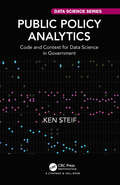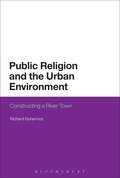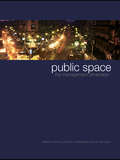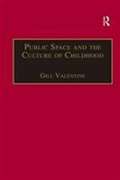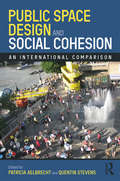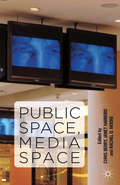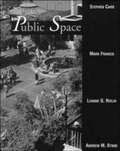- Table View
- List View
Public Places - Urban Spaces
by Tim Heath Taner Oc Steve TiesdellPublic Places Urban Spaces, 2e, is a thorough introduction to the principles of urban design theory and practice. Authored by experts in the fields of urban design and planning, it is designed specifically for the 2,500 postgraduate students on Urban Design courses in the UK, and 1,500 students on undergraduate courses in the same subject.The 2e of this tried and trusted textbook has been updated with relevant case studies to show students how principles have been put into practice. The book is now in full color and in a larger format, so students and lecturers get a much stronger visual package and easy-to-use layout, enabling them to more easily practically apply principles of urban design to their projects.Sustainability is the driving factor in urban regeneration and new urban development, and the new edition is focused on best sustainable design and practice. Public Places Urban Spaces is a must-have purchase for those on urban design courses and for professionals who want to update and refresh their knowledge.
Public Places - Urban Spaces
by Tim Heath Taner Oc Steve TiesdellPublic Places Urban Spaces, 2e, is a thorough introduction to the principles of urban design theory and practice. Authored by experts in the fields of urban design and planning, it is designed specifically for the 2,500 postgraduate students on Urban Design courses in the UK, and 1,500 students on undergraduate courses in the same subject.The 2e of this tried and trusted textbook has been updated with relevant case studies to show students how principles have been put into practice. The book is now in full color and in a larger format, so students and lecturers get a much stronger visual package and easy-to-use layout, enabling them to more easily practically apply principles of urban design to their projects.Sustainability is the driving factor in urban regeneration and new urban development, and the new edition is focused on best sustainable design and practice. Public Places Urban Spaces is a must-have purchase for those on urban design courses and for professionals who want to update and refresh their knowledge.
Public Policy Analytics: Code and Context for Data Science in Government (Chapman & Hall/CRC Data Science Series)
by Ken SteifPublic Policy Analytics: Code & Context for Data Science in Government teaches readers how to address complex public policy problems with data and analytics using reproducible methods in R. Each of the eight chapters provides a detailed case study, showing readers: how to develop exploratory indicators; understand ‘spatial process’ and develop spatial analytics; how to develop ‘useful’ predictive analytics; how to convey these outputs to non-technical decision-makers through the medium of data visualization; and why, ultimately, data science and ‘Planning’ are one and the same. A graduate-level introduction to data science, this book will appeal to researchers and data scientists at the intersection of data analytics and public policy, as well as readers who wish to understand how algorithms will affect the future of government.
Public Policy Analytics: Code and Context for Data Science in Government (Chapman & Hall/CRC Data Science Series)
by Ken SteifPublic Policy Analytics: Code & Context for Data Science in Government teaches readers how to address complex public policy problems with data and analytics using reproducible methods in R. Each of the eight chapters provides a detailed case study, showing readers: how to develop exploratory indicators; understand ‘spatial process’ and develop spatial analytics; how to develop ‘useful’ predictive analytics; how to convey these outputs to non-technical decision-makers through the medium of data visualization; and why, ultimately, data science and ‘Planning’ are one and the same. A graduate-level introduction to data science, this book will appeal to researchers and data scientists at the intersection of data analytics and public policy, as well as readers who wish to understand how algorithms will affect the future of government.
Public Private Partnerships in Construction
by Duncan CartlidgeCollaborative working and partnering between the public and private sectors has been fairly standard practice in some form or other for over 100 years, but it is only in recent years that it has become more prevalent. In the UK, it is little more than ten years since the most widely known Public Private Partnership (PPP), the Private Finance Initiative (PFI), was launched and yet it has already been described by some as 'the new economic paradigm.' Public Private Partnerships in Construction is an authoritative and objective source of information on PPPs, including lessons to be learnt from the past decade, as well as coverage of their spread beyond the UK to governments in areas as diverse as Cambodia and California. With its detailed presentation of current issues, illustrated with case studies, this book provides a valuable practical resource for a range of students and professionals.
Public Private Partnerships in Construction
by Duncan CartlidgeCollaborative working and partnering between the public and private sectors has been fairly standard practice in some form or other for over 100 years, but it is only in recent years that it has become more prevalent. In the UK, it is little more than ten years since the most widely known Public Private Partnership (PPP), the Private Finance Initiative (PFI), was launched and yet it has already been described by some as 'the new economic paradigm.' Public Private Partnerships in Construction is an authoritative and objective source of information on PPPs, including lessons to be learnt from the past decade, as well as coverage of their spread beyond the UK to governments in areas as diverse as Cambodia and California. With its detailed presentation of current issues, illustrated with case studies, this book provides a valuable practical resource for a range of students and professionals.
Public Religion and the Urban Environment: Constructing a River Town
by Richard Bohannon'Nature' and the 'city' have most often functioned as opposites within Western culture, a dichotomy that has been reinforced (and sometimes challenged) by religious images. Bohannon argues here that cities and natural environments, however, are both connected and continually affected by one another. He shows how such connections become overt during natural disasters, which disrupt the narratives people use to make sense of the world,including especially religious narratives, and make them more visible. This book offers both a theoretical exploration of the intersection of the city, nature, and religion, as well as a sociological analysis of the 1997 flood in Grand Forks, ND, USA. This case study shows how religious factors have influenced how the relationship between nature and the city is perceived, and in particular have helped to justify the urban control of nature. The narratives found in Grand Forks also reveal a broader understanding of the nature of Western cities, highlighting the potent and ethically-rich intersections between religion, cities and nature.
Public Religion and the Urban Environment: Constructing a River Town
by Richard Bohannon'Nature' and the 'city' have most often functioned as opposites within Western culture, a dichotomy that has been reinforced (and sometimes challenged) by religious images. Bohannon argues here that cities and natural environments, however, are both connected and continually affected by one another. He shows how such connections become overt during natural disasters, which disrupt the narratives people use to make sense of the world,including especially religious narratives, and make them more visible. This book offers both a theoretical exploration of the intersection of the city, nature, and religion, as well as a sociological analysis of the 1997 flood in Grand Forks, ND, USA. This case study shows how religious factors have influenced how the relationship between nature and the city is perceived, and in particular have helped to justify the urban control of nature. The narratives found in Grand Forks also reveal a broader understanding of the nature of Western cities, highlighting the potent and ethically-rich intersections between religion, cities and nature.
Public Service Broadcasting 3.0: Legal Design for the Digital Present (Routledge Research in Media Law)
by Mira BurriThe digital media environment is characterized by an abundance and diversity of content, a multiplicity of platforms, new modes of content production, distribution and access, and changed patterns of consumer and business behaviour. This has challenged the traditional model of public service broadcasting (PSB) in diverse ways. This book explores whether and how PSB should adapt to reflect the conditions of the digital media space so that it can effectively and efficiently continue to serve its public mandate. Drawing on literature on media governance in media and communication science, public international law as well as discussions on cyberlaw, Mira Burri maps and critically analyses existing policy and scholarly debates on PSB transformation. She challenges some of conventional rationales for reform, identifies new ones, as well as exposes the limitations placed upon existing and future policy solutions by global media governance arrangements, especially in the fields of trade, copyright and Internet governance. The book goes on to advance a future-oriented model of Public Service Media, which is capable of matching an environment of technological and of governance complexity. As a work that explores how public interest objectives can be pursued efficiently and sustainably in the digital media ecology, this book will be of great interest and use to students and researchers in media law, information technology law, and broadcast media studies, as well as to policy-makers.
Public Service Broadcasting 3.0: Legal Design for the Digital Present (Routledge Research in Media Law #8)
by Mira BurriThe digital media environment is characterized by an abundance and diversity of content, a multiplicity of platforms, new modes of content production, distribution and access, and changed patterns of consumer and business behaviour. This has challenged the traditional model of public service broadcasting (PSB) in diverse ways. This book explores whether and how PSB should adapt to reflect the conditions of the digital media space so that it can effectively and efficiently continue to serve its public mandate. Drawing on literature on media governance in media and communication science, public international law as well as discussions on cyberlaw, Mira Burri maps and critically analyses existing policy and scholarly debates on PSB transformation. She challenges some of conventional rationales for reform, identifies new ones, as well as exposes the limitations placed upon existing and future policy solutions by global media governance arrangements, especially in the fields of trade, copyright and Internet governance. The book goes on to advance a future-oriented model of Public Service Media, which is capable of matching an environment of technological and of governance complexity. As a work that explores how public interest objectives can be pursued efficiently and sustainably in the digital media ecology, this book will be of great interest and use to students and researchers in media law, information technology law, and broadcast media studies, as well as to policy-makers.
Public Service Broadcasting Online: A Comparative European Policy Study of PSB 2.0 (Palgrave Global Media Policy and Business)
by B. BreviniThis book investigates the extent to which a Public Service Broadcasting (PSB) ethos has been extended to the online world in Europe. It examines the most significant policy initiatives carried out by PSBs in Europe on online platforms, and analyzes how the public service philosophy is being reinvented by policy makers.
Public Space: The Management Dimension
by Matthew Carmona Claudio De Magalhães Leo HammondIn both the UK and the US there is a sense of dissatisfaction and pessimism about the state of urban environments, particularly with the quality of everyday public spaces. Explanations for this have emphasized the poor quality of design that characterizes many new public spaces; spaces that are dominated by parking, roads infrastructure, introspective buildings, a lack of enclosure and a poor sense of place, and which in different ways for different groups are too often exclusionary. Yet many well designed public spaces have also experienced decline and neglect, as the services and activities upon which the continuing quality of those spaces have been subject to the same constraints and pressures for change as public services in general. These issues touch upon the daily management of public space, that is, the coordination of the many different activities that constantly define and redefine the characteristics and quality of public space. This book draws on three empirical projects to examine the questions of public space management on an international stage. They are set within a context of theoretical debates about public space, its history, contemporary patterns of use and changing nature in western society, and about the new management approaches that are increasingly being adopted.
Public Space: The Management Dimension
by Matthew Carmona Claudio De Magalhães Leo HammondIn both the UK and the US there is a sense of dissatisfaction and pessimism about the state of urban environments, particularly with the quality of everyday public spaces. Explanations for this have emphasized the poor quality of design that characterizes many new public spaces; spaces that are dominated by parking, roads infrastructure, introspective buildings, a lack of enclosure and a poor sense of place, and which in different ways for different groups are too often exclusionary. Yet many well designed public spaces have also experienced decline and neglect, as the services and activities upon which the continuing quality of those spaces have been subject to the same constraints and pressures for change as public services in general. These issues touch upon the daily management of public space, that is, the coordination of the many different activities that constantly define and redefine the characteristics and quality of public space. This book draws on three empirical projects to examine the questions of public space management on an international stage. They are set within a context of theoretical debates about public space, its history, contemporary patterns of use and changing nature in western society, and about the new management approaches that are increasingly being adopted.
Public Space: notes on why it matters, what we should know, and how to realize its potential
by Vikas MehtaPublic Space: notes on why it matters, what we should know, and how to realize its potential journeys a vast territory and presents a panoramic view of public space—an understanding from numerous disciplines—under one cover in an incisive and concise manner. As a dialogue between the social-political and the material-physical, the book brings together the key ideas that encompass the social, political, and physical issues in the making and experience of public space. The book is at the same time a primer and a progressive text. It makes the case for public space, digs deep into understanding what public space is, followed by three sections that present the inherent paradoxes, the possibilities, and propositions for a more meaningful public space. The book presents ideas in concise and approachable ways—from established tenets to new propositions—that are constructive and thought-provoking, with many that will challenge the reader’s preconceived notions. Students and scholars in the built environment disciplines and social sciences, public space managers, public and private sector practitioners, and civic leaders, but also residents who want to better understand and make an impact in their communities and cities will find Public Space to be a valuable resource.
Public Space: notes on why it matters, what we should know, and how to realize its potential
by Vikas MehtaPublic Space: notes on why it matters, what we should know, and how to realize its potential journeys a vast territory and presents a panoramic view of public space—an understanding from numerous disciplines—under one cover in an incisive and concise manner. As a dialogue between the social-political and the material-physical, the book brings together the key ideas that encompass the social, political, and physical issues in the making and experience of public space. The book is at the same time a primer and a progressive text. It makes the case for public space, digs deep into understanding what public space is, followed by three sections that present the inherent paradoxes, the possibilities, and propositions for a more meaningful public space. The book presents ideas in concise and approachable ways—from established tenets to new propositions—that are constructive and thought-provoking, with many that will challenge the reader’s preconceived notions. Students and scholars in the built environment disciplines and social sciences, public space managers, public and private sector practitioners, and civic leaders, but also residents who want to better understand and make an impact in their communities and cities will find Public Space to be a valuable resource.
Public Space And The Culture Of Childhood
by Gill ValentineChildren are at the heart of popular and public debates in North America and Europe about the culture of public space. On the one hand there is increased anxiety about children's vulnerability to stranger danger, on the other there is a rising tide of fear about out of control and dangerous youth. This book addresses both these debates about children's role in public space, setting them within an academic framework and drawing on a range of interdisciplinary work on childhood, young people and parenting. It is therefore relevant to practitioners and policy makers concerned with the nature and future of public space, and to academics researching or teaching about childhood, family or public space in the disciplines of sociology, social policy and geography
Public Space And The Culture Of Childhood (PDF)
by Gill ValentineChildren are at the heart of popular and public debates in North America and Europe about the culture of public space. On the one hand there is increased anxiety about children's vulnerability to stranger danger, on the other there is a rising tide of fear about out of control and dangerous youth. This book addresses both these debates about children's role in public space, setting them within an academic framework and drawing on a range of interdisciplinary work on childhood, young people and parenting. It is therefore relevant to practitioners and policy makers concerned with the nature and future of public space, and to academics researching or teaching about childhood, family or public space in the disciplines of sociology, social policy and geography
Public Space and Relational Perspectives: New Challenges for Architecture and Planning
by Chiara Tornaghi Sabine KnierbeinTraditional approaches to understand space tend to view public space mainly as a shell or container, focussing on its morphological structures and functional uses. That way, its ever-changing meanings, contested or challenged uses have been largely ignored, as well as the contextual and on-going dynamics between social actors, their cultures, and struggles. The key role of space in enabling spatial opportunities for social action, the fluidity of its social meaning and the changing degree of "publicness" of a space remain unexplored fields of academic inquiry and professional practice. Public Space and Relational Perspectives offers a different understanding of public spaces in the city. The aim of the book is to (re)introduce the lived experiences in public life into the teaching curricula of those academic disciplines which deal with public space and the built environment, such as architecture, planning and urban design, as well as the social sciences. The book presents conceptual, practical and research challenges and brings together findings from activists, practitioners and theorists. The editors provide eight educational challenges that educators can endorse when training future practitioners and researchers to accept and to engage with the social relations that unfold in and through public space. Cover image: KARO*
Public Space and Relational Perspectives: New Challenges for Architecture and Planning
by Chiara Tornaghi Sabine KnierbeinTraditional approaches to understand space tend to view public space mainly as a shell or container, focussing on its morphological structures and functional uses. That way, its ever-changing meanings, contested or challenged uses have been largely ignored, as well as the contextual and on-going dynamics between social actors, their cultures, and struggles. The key role of space in enabling spatial opportunities for social action, the fluidity of its social meaning and the changing degree of "publicness" of a space remain unexplored fields of academic inquiry and professional practice. Public Space and Relational Perspectives offers a different understanding of public spaces in the city. The aim of the book is to (re)introduce the lived experiences in public life into the teaching curricula of those academic disciplines which deal with public space and the built environment, such as architecture, planning and urban design, as well as the social sciences. The book presents conceptual, practical and research challenges and brings together findings from activists, practitioners and theorists. The editors provide eight educational challenges that educators can endorse when training future practitioners and researchers to accept and to engage with the social relations that unfold in and through public space. Cover image: KARO*
Public Space and the Challenges of Urban Transformation in Europe
by Ali Madanipour Sabine Knierbein Aglaée DegrosEuropean cities are changing rapidly in part due to the process of de-industrialization, European integration and economic globalization. Within those cities public spaces are the meeting place of politics and culture, social and individual territories, instrumental and expressive concerns. Public Space and the Challenges of Urban Transformation in Europe investigates how European city authorities understand and deal with their public spaces, how this interacts with market forces, social norms and cultural expectations, whether and how this relates to the needs and experiences of their citizens, exploring new strategies and innovative practices for strengthening public spaces and urban culture. These questions are explored by looking at 13 case studies from across Europe, written by active scholars in the area of public space and organized in three parts: strategies, plans and policies multiple roles of public space and everyday life in the city. This book is essential reading for students and scholars interested in the design and development of public space. The European case studies provide interesting examples and comparisons of how cities deal with their public space and issues of space and society.
Public Space and the Challenges of Urban Transformation in Europe
by Ali Madanipour Sabine Knierbein Aglaée DegrosEuropean cities are changing rapidly in part due to the process of de-industrialization, European integration and economic globalization. Within those cities public spaces are the meeting place of politics and culture, social and individual territories, instrumental and expressive concerns. Public Space and the Challenges of Urban Transformation in Europe investigates how European city authorities understand and deal with their public spaces, how this interacts with market forces, social norms and cultural expectations, whether and how this relates to the needs and experiences of their citizens, exploring new strategies and innovative practices for strengthening public spaces and urban culture. These questions are explored by looking at 13 case studies from across Europe, written by active scholars in the area of public space and organized in three parts: strategies, plans and policies multiple roles of public space and everyday life in the city. This book is essential reading for students and scholars interested in the design and development of public space. The European case studies provide interesting examples and comparisons of how cities deal with their public space and issues of space and society.
Public Space Design and Social Cohesion: An International Comparison
by Patricia Aelbrecht Quentin StevensSocial cohesion is often perceived as being under threat from the increasing cultural and economic differences in contemporary cities and the increasing intensity of urban life. Public space, in its role as the main stage for social interactions between strangers, clearly plays a role in facilitating or limiting opportunities for social cohesion. But what exactly is social cohesion, how is it experienced in the public realm, and what role can the design of city spaces have in supporting or promoting it? There are significant knowledge gaps between the social sciences and design disciplines and between academia and practice, and thus a dispersed knowledge base that currently lacks nuanced insight into how urban design contributes to social integration or segregation. This book brings together scholarly knowledge at the intersection of public space design and social cohesion. It is based on original scholarly research and a depth of urban design practice, and analyses case studies from a variety of cities and cultures across the Global North and Global South. Its interdisciplinary, cross-cultural analysis will be of interest to academics, students, policymakers and practitioners engaged with a range of subject areas, including urban design, urban planning, architecture, landscape, cultural studies, human geography, social policy, sociology and anthropology. It will also have significant appeal to a wider non-academic readership, given its topical subject matter.
Public Space Design and Social Cohesion: An International Comparison
by Patricia Aelbrecht Quentin StevensSocial cohesion is often perceived as being under threat from the increasing cultural and economic differences in contemporary cities and the increasing intensity of urban life. Public space, in its role as the main stage for social interactions between strangers, clearly plays a role in facilitating or limiting opportunities for social cohesion. But what exactly is social cohesion, how is it experienced in the public realm, and what role can the design of city spaces have in supporting or promoting it? There are significant knowledge gaps between the social sciences and design disciplines and between academia and practice, and thus a dispersed knowledge base that currently lacks nuanced insight into how urban design contributes to social integration or segregation. This book brings together scholarly knowledge at the intersection of public space design and social cohesion. It is based on original scholarly research and a depth of urban design practice, and analyses case studies from a variety of cities and cultures across the Global North and Global South. Its interdisciplinary, cross-cultural analysis will be of interest to academics, students, policymakers and practitioners engaged with a range of subject areas, including urban design, urban planning, architecture, landscape, cultural studies, human geography, social policy, sociology and anthropology. It will also have significant appeal to a wider non-academic readership, given its topical subject matter.
Public Space, Media Space
by Chris Berry, Janet Harbord and Rachel MoorePublic Space, Media Space asks how media saturation are transforming public space and our experience of it. From the role of graffiti and Youtube videos of street art in the Cairo revolution, to OOH (Out of Home) advertising, the book is diverse in its approach and global in its coverage.
Public Space (Environment And Behavior Ser.)
by Stephen Carr Mark Francis Leanne G. Rivlin Andrew M. Stone Irwin Altman Daniel StokolsThis book reveals the social basis for public space use, design and management. The authors - an architect/environmental designer, a landscape architect, an environmental psychologist, and an open space administrator - offer a well-integrated perspective of how to integrate public space and public life. They contend that three critical human dimensions should guide the process of design and management of public space: the users' essential needs, their spatial rights, and the meanings they seek. To develop and explain these three dimensions, the authors draw on the history of public life and public space, evidence from recent social research, and a series of original case studies, all amply illustrated. Public Space offers an innovative approach for adapting the dimensions to the unique social and environmental context of each project.

